Nightmare Alley is a seedy, film noir planet of greed, regret, and psychosis.
The motion picture tracks the tale of the down-on-his-luck Stan Carlisle (Bradley Cooper), who walks on to the display screen as a mysterious stranger. His chance arrival at a filth-ridden carnival in 1939 snowballs into a increasing profession. Employing trickery to look omniscient, his act can take New York by storm.
This Melancholy-period planet was created by generation designer Tamara Deverell (Cabinet of Curiosities, Star Trek: Discovery), who has been nominated for an Academy Award in Creation Style and design for her function on Nightmare Alley. Deverell led the film’s layout, recreating environments with excessive historic precision, capturing the sickening actuality glance of Midwestern carnivals of that time and the prosperous influence of artwork deco household furniture and architecture in New York.
(Of course, you need to hope spoilers forward.)
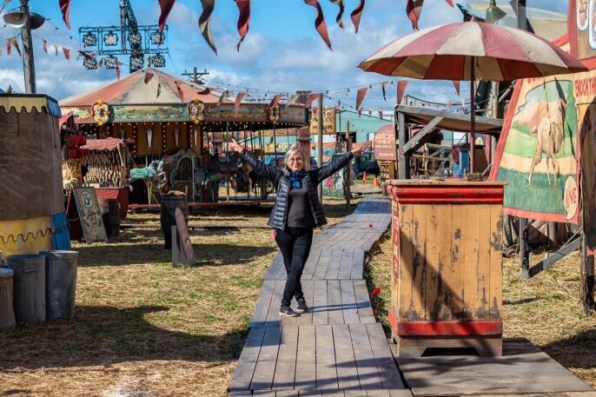
While uncredited for the operate, Deverell actually made a couple of the sets on director Guillermo del Toro’s prior Oscar-nominated movie, Shape of H2o. Del Toro is well known for films that vary from significant art to comedian e book, all tending to target on otherworldly creatures as both the heroes or oft-misunderstood villains.
“For Guillermo, [Nightmare Alley] was a various movie,” suggests Deverell. “It was not a creature motion picture. The monsters ended up all adult males and girls, definitely.”
In fact, from the film’s opening scenes, Nightmare Alley is stomach-churning to enjoy. From the earliest frames, I suspect Carlisle has just arrived in purgatory. Even as he escapes poverty and finds himself surrounded by riches, a sense of foreboding fills every scene and set. For the reason that at times your dreams end as nightmares.
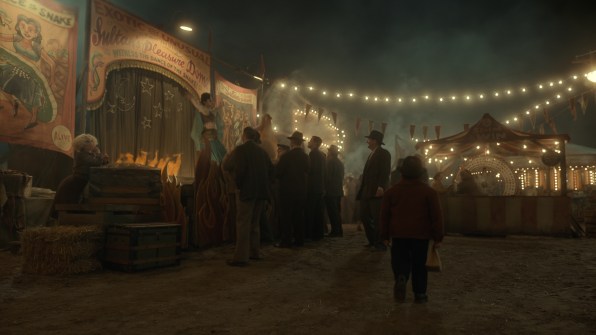
The carnival that circles again
The movie begins with Carlisle arriving by practice to a dusty carnival somewhere in Center The us. This is not a fantastical wonderland. It’s dirty, with tents stained the very same uninteresting brown as the floor.
“Quite truthfully, we started out just digging into a ton of investigate. We experienced great sources with the Library of Congress and Smithsonian of initial carnivals in the 1920s and ’30s. I required to make it as true as doable,” states Deverell. “My historic memory, the memory you make up when you feel about that time in heritage, had it as quite dusty and dirty and a unfortunate place. I was remaining educated by photographs, paintings, and illustrations of the time.”
To construct this carnival and just about everything else in the film, the workforce genuinely developed it. Rather than computer system-produced graphics, the movie relied on physically developing sets and furnishings in the period design. That meant hand painting the carnival banners and distressing the tents to give them that aged glimpse.
“Given that it was a morally dim movie, I just embraced that,” suggests Deverell. “It usually means richer hues to me.” Certainly, the film is saturated across the board, with very similar distinction but infinitely additional color than a traditional, black-and-white noir film.
Deverell also utilised the carnival to introduce the key motif to the film: circles. Circles engage in out visually, likely as a way to cement the round nature of the plot by itself.
She factors out that this circle motif starts in the geek pit, a grotesque-but-real area in carnivals, exactly where a geek—an in any other case unskilled carnival worker (who was often an alcoholic compensated in liquor)—would be tossed a live animal and bite the head off. The pit is made as a circle, a trace that Carlisle will, in outcome, circle back to it at the conclude of the movie. Deverell peppers much more circles in the course of the carnival, but its other most-noteworthy placement is in a simulated electric chair built by Carlisle for the carnival demonstrate.
Powering the chair spins a significant round world-wide-web, which does nothing at all in the movie to drive the electric power, and is meant to provide as a bit of excess theater to the general public. As it turns out, this bit of sly showmanship is designed on some historic accuracy.
“I specifically took that from a image of the inventor Nicolas Tesla—there’s a picture that has this,” says Deverell. “I showed it to Guillermo, we tried out that in illustrations, and we created it so you could twirl it.” Later on, Carlisle performs his clearly show at a swanky supper club that Deverell created to be a person large circle (or, a fancier geek pit).
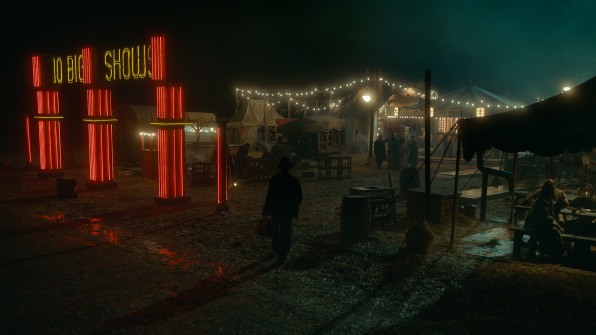
The completely imperfect vintage neon
A second visible motif released in this element of the movie was neon, and it is admittedly a bit jarring on display. When the carnival is in tatters, its entrance is an intricate, glowing-purple neon arch—a contact that feels way too grand for the dilapidated state of the fair. (Once again, generating me marvel if this carnival was a actuality outside of our individual.)
“That full neon entrance was incredibly considerably a very last-minute, mind-bending ask for of Guillermo’s, to do an homage to Hitchcock’s Strangers on a Teach, which has a carnival [with neon],” she clarifies.
For Deverell, providing this neon was a key challenge since it was all personalized do the job. “This requires time! It was challenging. We broke it numerous situations,” she suggests. “Even Bradley Cooper leaned on it once, and one particular of the bulbs cracked.”
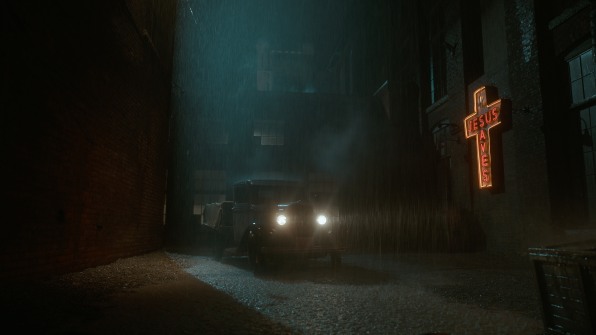
The neon was particularly fragile mainly because it was fashioned in its common, early 20th century design and style, to capture the reliable luminosity of neon of that period. “Now it’s all plexi block,” explains Deverell, alluding to the use of composite blocking to stabilize neon indications as opposed to fragile, hand-twisted glass tubes. “We constructed it with our neon dude, the authentic previous-fashioned way with out it remaining boxed, which is section of the cause we were being so nervous about it, and it can existing difficulties. But to do a time period motion picture, you have to do it in a time period way.” Even the color of neon, its individual pink, was a color that existed in the era.
Neon is utilized later on in the film, too—though a big neon indicator for the film’s supper club in no way produced it to monitor. Most notably, you can spot a significant neon cross in an alley where by Carlisle dumps a geek who is unwell and close to death.
The cross was really influenced by situations of decades before, when Deverell was artwork directing on del Toro’s 1997 film Mimic. That movie functions a neon cross, which del Toro had noticed on a Jesus Will save sign in Toronto. The director asked Deverell to convey it back for Nightmare Alley, expressing, “Remember that cross? I adore that cross.”
“It’s our individual small Easter Egg,” says Deverell.
But filming the neon cross—especially in a scene in which it’s raining at night—was tough. “I obtained a cellular phone call from our producer that the [electric technicians] had been possessing a tough time managing the neon. It was flickering,” suggests Deverell. So the lovingly built indicator was going to be replaced with electronic effects—that is, till editors, and presumably del Toro, saw the effects. A indicator that was fifty percent burned-out added a haunting aspect to the scene, which a absolutely useful sign could not.
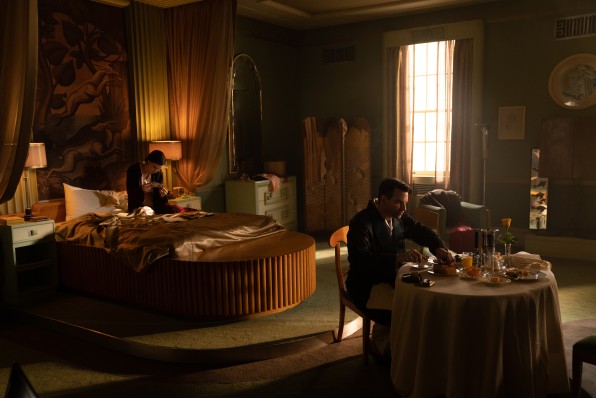
The workplace that is seriously a nightmare alley
Just after Carlisle leaves the carnival guiding, the film’s backdrop variations entirely. We’re ushered from the dusty Midwest into the ritzy earth of the coastal higher class. Provided that this was the period of artwork deco, these environments are filled with this rich, embellished style—one that celebrates humanist curves and proportions correct together with hard, industrial angles.
1 placing of specific emphasis was the office of psychiatrist Lillith Ritter (Cate Blanchett), who, following currently being publicly humiliated by Carlisle in the course of his mentalist exhibit, operates tough to acquire his have faith in, only to damage his existence. Her business is an expansive, marble-floored tomb. Her desk, nevertheless, options a abundant wood-veneer wall that’s the two absolutely genuine and painstakingly handmade.
“When I very first put pen to paper in my sketches, [the office] was 50 percent the size it finished up currently being. We pretty much stood there at the computer system, our set designer [and I], and retained lengthening the established. ‘Let’s make it for a longer time, let’s make it for a longer time!’” says Deverell. “Guillermo actually wanted this alley. It turned a theme. Almost everything is prolonged and slender.” Developing the excellent household furniture to fill such a large area was tricky in alone, however it also made the possibility for jaw-dropping objects like the office’s tailor made-designed chaise lounge, which anchors the house like a looming black hole. Deverell also notes how simply Blanchett performs her way as a result of that significant established soon after cautiously choreographing each individual conquer.
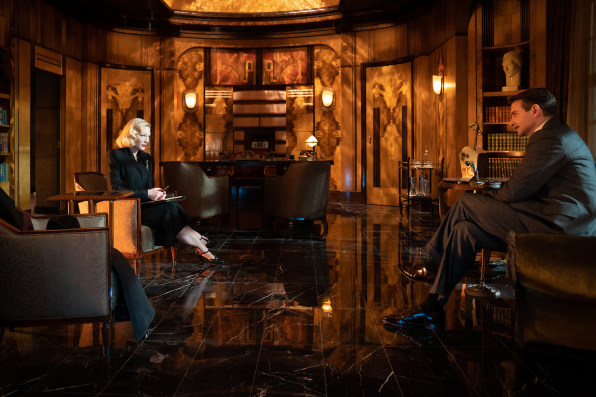
As for the wooden-veneer wall behind her desk, that was impressed by an installation in the Brooklyn Museum, the place Deverell frequented, nose-to-glass, finding out an artwork deco place of work that is on show. She credits the museum curators, who answered all sorts of concerns she experienced about the use of wood in the era, as creating that wall doable. By the time Ritter reveals up on screen, she inhabits anything but a further stereotypical, wooden-and-brass psychiatrist’s business. This wooden facade anchors the era and the character at the same time.
“It was seriously happenstance that the veneers turned out to be these kind of Rorschach visuals,” claims Deverell, noting how the parallel style and design of the reserve-finished picket backdrop mirrors the inky blots of Rorschach. “I was not intending it.”
The wooden wall contrasts against the office, with a cold marble ground that retains the complete scene on edge. Truthfully, Deverell experienced constantly imagined that floor to be carpeted, considering that carpeting was in manner in Europe, and Ritter’s character would have been up to date on developments.
“We nearly finished the established, laid the carpet down, and it seemed tasteful. But you desired this tricky edge for this hard-edged girl, who is as significantly a monster as any individual in the movie. She’s a con female who out drawbacks the con gentleman!” states Deverell. “In the stop, we just took it out because of the click, simply click, click of her heels.”
Nightmare Alley is streaming on HBO Max now.









More Stories
The Ten SolarScape Artworks | The Unfathomable Artist
Industrial Materials Reconstruct Local History on a Monumental Scale in Public Sculptures by David Mach — Colossal
12 Terrific DIY Projects for Your Art Room to Get Started On Immediately